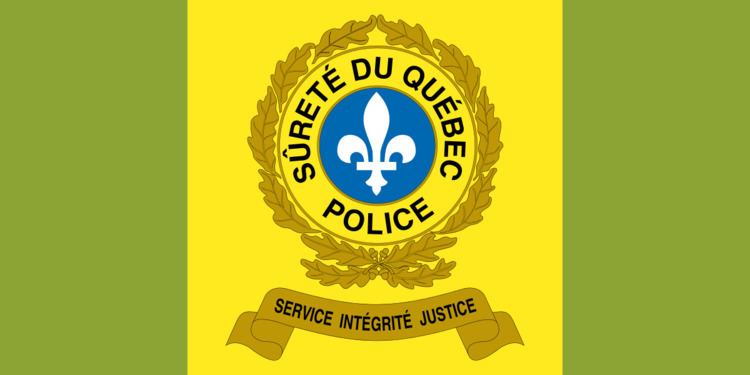Abbreviation SQ Size 1,542,056 km | Formed May 1, 1870 | |
 | ||
Motto Service, Intégrité, JusticeService, Integrity, Justice Legal personality Governmental: Government agency | ||
Sûreté du Québec ([syʁte dy kebɛk], Quebec Safety), abbreviated SQ, is the provincial police force for the Canadian province of Quebec. No official English name exists, but Quebec Provincial Police (QPP) and Quebec Police Force (QPF) are commonly used. The headquarters of the Sûreté du Québec are located on Parthenais street in Montreal and the force employs roughly 5,200 officers. SQ is the second largest provincial force (behind the Ontario Provincial Police) and fourth largest force in Canada (behind the Toronto Police Service, Ontario Provincial Police, and the Royal Canadian Mounted Police).
Contents
- History
- Montebello incident
- Licence Plate Recognition System
- Chiefs and Directors general
- Districts
- Rank badges
- Uniforms
- Fleet
- Equipment
- References
The primary function of the Sûreté du Québec is to enforce provincial laws, some municipal bylaws, the Criminal Code, and many other laws throughout Quebec and to assist municipal police forces when needed. Members of the force can also legally act as forest conservation agents for example. The Sûreté du Québec is also responsible for providing municipal police services to municipalities in the province that do not otherwise have municipal or regional police services. Currently that includes municipalities with under 50,000 people. As such, the force is mainly present in small rural and suburban areas. The force also patrols provincial highways. In addition, the Sûreté du Québec can investigate any incident that involves wrongdoing by a municipal police force or a case where a police intervention caused death.
In the early 2000s, the force absorbed many smaller police services (e.g., Drummondville and Saint-Hyacinthe).
History
On February 1, 1870, the Quebec provincial government created the Police provinciale du Québec under the direction of its first commissioner, Judge Pierre-Antoine Doucet. This new force took over the headquarters of the Quebec City municipal police, which were then disbanded, although the city relaunched a municipal force in 1877.
In 1900, two distinct provincial police forces were created: the Office of Provincial Detectives of Montreal, in response to a crime wave in that city, and the Revenue Police, whose mission was to collect taxes. In 1902, the government decided that the provincial police should no longer be directed by a judge but by an officer of the police themselves. Augustin McCarthy was chosen as the first chief drawn from the ranks of the police.
In 1922, two headquarters were established, one in Quebec City, headed by McCarthy, and one in Montreal, headed by Dieudonné Daniel Lorrain. The Office of Provincial Detectives of Montreal became part of the general provincial police in that year. The Quebec division included 35 police officers and two detectives.
In 1925, police officers started patrolling on motorcycles. In 1929 and 1930, the structure of the force was reformed and the agency adopted a new name as Sûreté provinciale du Québec which was later shortened to its present name.
Montebello incident
The Sûreté du Québec admitted in August 2007 that they had used undercover police posing as protestors at the 2007 Montebello Security and Prosperity Partnership of North America meetings. This admission was made after a video captured by protestors was widely circulated in the Canadian media and made available on YouTube. It is not uncommon to make use of undercover agents at protests of this kind, but the video was especially controversial because it appeared to show one of the officers carrying a rock, suggesting to some viewers that the police may have been acting as agents provocateurs by inciting violence.
Licence Plate Recognition System
The Sûreté du Québec has been using the LPRS systems since 2009. The objective of the LPRS is to make the streets and highways safer by removing vehicles not authorized to be on the road. The hotlist plate database can consist of the following types:
The LPRS are installed on 10 Sûreté du Québec vehicles. The LPRS integrator is Gtechna. Gtechna is primarily a citations issuance and management software developer which integrates mission critical technologies such as Licence Plate Recognition (LPR) to streamline the enforcement of moving and parking violations.
Chiefs and Directors-general
Districts
- Bas-Saint-Laurent-Gaspésie-Îles-de-la-Madeleine
- Saguenay-Lac-Saint-Jean
- Capitale-Nationale-Chaudière-Appalaches
- Mauricie-Centre-du-Québec
- Estrie
- Montréal-Laval-Laurentides-Lanaudière
- Outaouais
- Abitibi-Témiscamingue-Nord-du-Québec
- Côte-Nord
- Montérégie
Rank badges
Rank insignia of the Sûreté du Québec are on contained on "slip on" sleeves worn on the epaulettes of uniform jacket or shirt shoulders.
Constables do not have any insignia on their uniform.
The rank insignia:
Uniforms
Early uniforms were British in origins including the use of the Custodian helmet, with the Kepi later added as well. The force adopted a uniform with a more distinct green tone, as well as a peaked cap, in the 1960s.
The emblem of the force changed in the 1970s when the old provincial coat of arms gave way to the fleur-de-lis.
In late 2016, Martin Prud'Homme, Director General of the SQ, announced the uniforms would be changed. Shirts would become olive green, the patches black, the pants blue-black, and the bulletproof vests would become black.
Fleet
Cars:
Trucks:
Motorcycles:
Special Vehicles:
Air:
Sea:
Wild:
Miscellaneous:
Equipment
The standard-issue weapon of Sûreté du Québec is the Glock pistol loaded in 9×19mm Parabellum caliber. Various models are adopted such as the standard Glock 17, compact Glock 19 and sub-compact Glock 26. Tactical officers used CQB Close Quarter Battle combat rifle—variant of Colt Canada C8 rifle.
